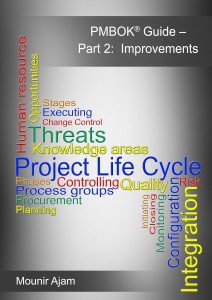 In a previous article, we discussed a few inconsistencies in the PMBOK® Guide. That topic is a chapter in an upcoming e-book on how the guide current reality. In another e-book, we discuss improvements to the guide; this article is a chapter in this second e-book.
In a previous article, we discussed a few inconsistencies in the PMBOK® Guide. That topic is a chapter in an upcoming e-book on how the guide current reality. In another e-book, we discuss improvements to the guide; this article is a chapter in this second e-book.
What are the inconsistencies?
The following is a list, from Part 1, of the topics that we believe have inconsistencies and even errors in the PMBOK® Guide.
- Terminology,
- Audit,
- Quality assurance,
- Project life cycle and project success,
- Control the team,
- Acquire the team,
- Scope and executing,
- Where is the control reference, and
- Monitor versus control.
Terminology
Project or phase
As discussed in Part 1, it is unfortunate that a few processes have the word ‘project’ in their names, even though these processes are for the project or phase. This naming approach implies, or influence, professionals to think these processes are about the project rather than the phase. Therefore, our recommendation is to change the names of these processes by dropping the word ‘project’ from the name. Alternatively, change it to include ‘project or phase’, as the ‘close project or phase’ process.
Consistency of other processes’ names
This item is not as vital as the previous one, but it is still relevant.
It is recommended that some of the processes’ names should reflect the core purpose of each process and its primary output; if they are not already. For example, instead of ‘define scope’ process, change it to ‘create scope statement’ or ‘develop scope statement’. This offers the user more clarity on the purpose of the process.
Audit
As presented in Part 1, the word “audit” representing an audit action (function) is mentioned in various process groups, although the concept of an audit is the same across various domains or functions. Our recommendation is for the PMBOK® Guide update team to consider this situation and decide if the use of audit and its purpose is the same across knowledge areas. It is, and then the guide should be consistent, and audit must be included in one process group, our recommendation is audit is in monitoring and controlling.
Quality assurance
Quality assurance is mostly about quality management, audit and process improvements.
- In the case of an audit, the team (or external auditor) need to review and assess the current action and performance to decide if it comply with the organizational processes and if not, act to correct.
- For process improvements, the team will assess current system (policies, procedures, processes) to assess if there are needs for improvement and take action.
Therefore, in both situations there are reviews (monitoring actions) and corrections if required (control actions). Therefore, quality assurance should be monitoring and controlling process, not an executing process.
Project life cycle and project success
We touched on this in the earlier chapter, item 3.6, and that would address this inconsistency.
Split the ‘manage the team’ process
Due to the absence of any process for the monitoring and controlling process group for the human resource knowledge area, we recommend the following. Split the manage the team process into manage the team, which would be about directing and coordinating the teamwork, and control project team to handle any control aspects, variances, changes, or adjustments to the team.
Acquire the team
Earlier, we had explained the area of confusion and inconsistency regarding acquiring the various resources for the project. Just a refresher, the guide has a process for acquiring the team in the executing process group. Technically, this is not totally correct since in executing we acquire the technical and functional resources that will perform the “executing” work. The other parts of the team, namely the project manager and the project management team are acquired earlier.
Therefore, our recommendation is to add to the PMBOK® Guide two processes:
- A process for acquiring the project manager. Acquiring the project manager could be a significant effort for medium to large projects. If the projects are small and simple, and appointing a project manager is simple, then we can skip this process. In term of the process groups, this is in initiating.
- A process for acquiring the project management team members in the planning process group. This process can also include provisions for adding members to the project management team during the executing processes when the effort grows significantly. In a situation where there is no project management team, and the project manager is THE team, then we skip this process.
Scope and executing
To avoid repetition, the inconsistencies were explained in Part 1, like the other topics. Therefore, it would be our recommendation to add a process in the scope management area, executing process groups, with the name ‘complete work packages.’
Where is the control reference?
The control reference is a big topic, and we are not sure if we can address adequately here, without deviating too much from the core objective of this e-book series. It would be best to address this topic in the chapter in Section II on Managing the Project Life Cycle.
Monitor and control
Once again, please refer to Part 1 for a refresher if you forgot about this topic.
It is our preference to split the monitoring and controlling process group into two process groups in line with the original PDCA concept. However, this is a preference and nice to have but we are not making a strong case for recommending a split at this time. Maybe a future discussion.
